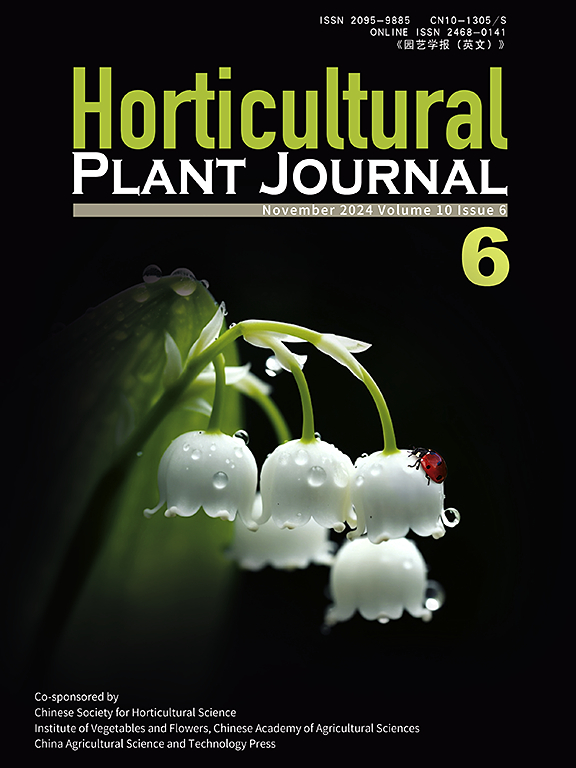利用优化的PCR和KASP标记提高四倍体马铃薯抗病基因Rx1和Rx2的检测效率
IF 6.2
1区 农林科学
Q1 HORTICULTURE
引用次数: 0
摘要
马铃薯X病毒(PVX)严重威胁全球马铃薯种植,有必要更深入地了解抗性的遗传机制。Rx1和Rx2基因在选育具有广谱PVX抗性的马铃薯中起着关键作用。然而,目前这些基因的DNA标记存在不确定性,因为它们既存在于抗性材料中,也存在于易感材料中,这使得鉴定抗性基因变得复杂。本研究旨在开发高通量分子标记,特别是竞争性等位基因特异性PCR (KASP)标记,以可靠地检测Rx1和Rx2基因。对7个抗性基因型和4个易感基因型进行遗传多态性分析,发现7个单核苷酸多态性(snp)和1个插入缺失(Indel), Rx1和Rx2蛋白序列的氨基酸发生相应变化。基于这些差异,开发了高通量分子标记。值得注意的是,引物对Rx1- 1r - f + Rx1- 5r - r和Rx2- 1r2 - f + Rx2- 2r2 - r检测Rx1和Rx2基因的准确性较高,无假阳性和假阴性。优化的多重PCR方案也显示出同时检测两个基因的强大潜力。针对Rx1 CDS中2 515位(G ~ C)和Rx2 CDS中2 445位(C ~ G) snp的KASP标记可有效区分杂合抗性基因型和纯合易感基因型。此外,这些标记在243个和133个多杂交后代中有效地鉴定了Rx1和Rx2基因型。通过PCR或KASP检测Rx1和Rx2阳性的后代对PVX表现出极端抗性(ER),而阴性的后代对PVX敏感。这些发现突出了所开发的标记在加速育种周期和提高抗pvx马铃薯品种产量方面的潜力。本文章由计算机程序翻译,如有差异,请以英文原文为准。
Improving detection of potato virus X resistance genes Rx1 and Rx2 in tetraploid potato using optimized PCR and KASP markers
Potato virus X (PVX) seriously threatens global potato cultivation, necessitating a deeper understanding of the genetic mechanisms responsible for resistance. The Rx1 and Rx2 genes play a pivotal role in breeding potatoes with broad-spectrum PVX resistance. However, current DNA markers for these genes present uncertainties, as they are found in both resistant and susceptible materials, complicating the identification of the responsible resistance gene. This study aimed to develop robust high-throughput molecular markers, specifically Kompetitive Allele-Specific PCR (KASP) markers, to reliably detect the Rx1 and Rx2 genes. Genetic polymorphism analysis of seven resistant and four susceptible potato genotypes revealed seven single nucleotide polymorphisms (SNPs) and one insertion-deletion (Indel), along with corresponding amino acid changes in the Rx1 and Rx2 protein sequences. Based on these variations, high-throughput molecular markers were developed. Notably, the primer pairs Rx1-1R-F + Rx1-5R-R and Rx2-1R2-F + Rx2-2R2-R showed high accuracy, detecting Rx1 and Rx2 genes without false positives or false negatives. Optimized multiplex PCR protocols also demonstrated strong potential in simultaneously detecting both genes. KASP markers targeting SNPs at positions 2 515 (G to C) in the Rx1 CDS and 2 445 (C to G) in the Rx2 CDS efficiently differentiated between heterozygous resistant and homozygous susceptible genotypes. Furthermore, these markers effectively identified Rx1 and Rx2 genotypes in 243 and 133 progenies across multiple crosses. Progenies that tested positive for Rx1 and Rx2 through PCR or KASP assays exhibited extreme resistance (ER) to PVX, while negative progeny was susceptible. These findings highlight the potential of the developed markers to accelerate the breeding cycle and improve the production of PVX-resistant potato varieties.
求助全文
通过发布文献求助,成功后即可免费获取论文全文。
去求助
来源期刊

Horticultural Plant Journal
Environmental Science-Ecology
CiteScore
9.60
自引率
14.00%
发文量
293
审稿时长
33 weeks
期刊介绍:
Horticultural Plant Journal (HPJ) is an OPEN ACCESS international journal. HPJ publishes research related to all horticultural plants, including fruits, vegetables, ornamental plants, tea plants, and medicinal plants, etc. The journal covers all aspects of horticultural crop sciences, including germplasm resources, genetics and breeding, tillage and cultivation, physiology and biochemistry, ecology, genomics, biotechnology, plant protection, postharvest processing, etc. Article types include Original research papers, Reviews, and Short communications.
 求助内容:
求助内容: 应助结果提醒方式:
应助结果提醒方式:


